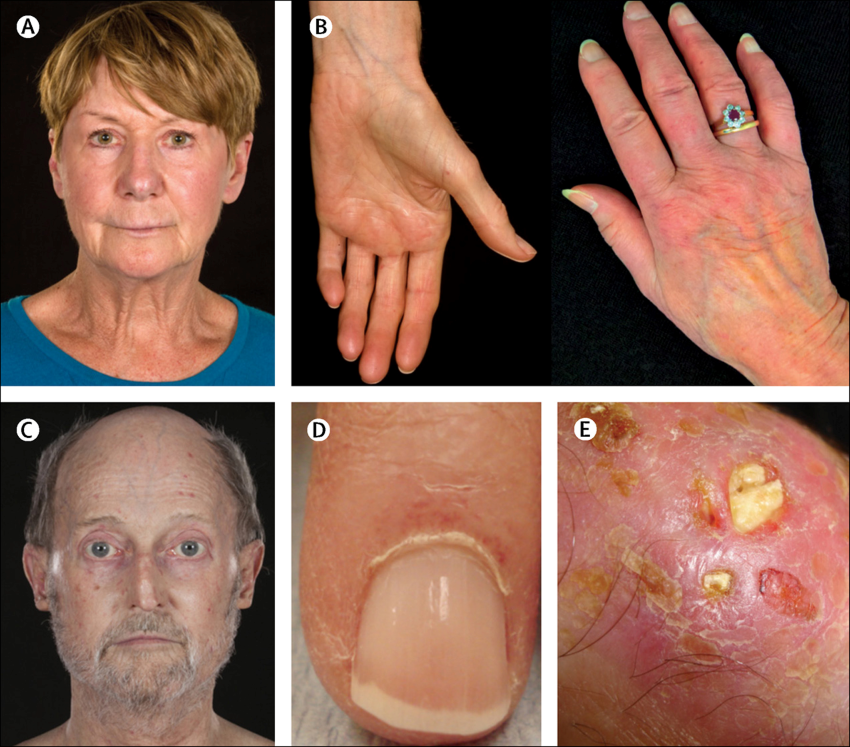Clinical features of systemic sclerosis
Systemic sclerosis is characterised by scleroderma1, inflammation and fibrosis of multiple organs and tissues. Two main disease variants exist, defined by the extent of skin involvement:
- limited systemic sclerosis
- diffuse systemic sclerosis.
Clinical features of systemic sclerosis by organ system or body region are listed in Clinical features of systemic sclerosis. For images of some of the characteristic features, see Diffuse cutaneous systemic sclerosis and Limited cutaneous systemic sclerosis.
Raynaud phenomenon and gastro-oesophageal reflux are often the first symptoms of systemic sclerosis.Denton, 2017
Organ system or body region affected by systemic sclerosis | Clinical features |
|---|---|
|
Skin and subcutaneous tissue | |
|
scleroedema (early stage) |
inflammation, oedema, pruritis, thickening of the skin |
|
scleroderma [NB2] (later stages) |
local or general skin thickening and fibrosis linear scleroderma atrophic skin with loss of sebaceous gland and hair follicles |
|
facial change |
change in cosmetic appearance (eg tight, shiny, thickened skin) reduced oral aperture and trismus see images of facial changes in diffuse disease and limited disease |
|
digital fibrosis | |
|
calcinosis and ulcers (calcinosis cutis) |
deposition of insoluble calcium in the skin and subcutaneous tissues painful calcinotic deposits that may extrude and ulcerate; see calcinosis cutis |
|
Oral and dental | |
|
oral mucosa |
sicca symptoms (dry mouth), oral ulcers |
|
dentition |
difficult dental hygiene gum and dental disease, secondary to small oral aperture, trismus and sicca |
|
Ophthalmic | |
|
ocular surface | |
|
Musculoskeletal | |
|
joints and muscles |
arthralgias, arthritis, tenosynovitis, myalgias, myositis (especially overlap myositis) |
|
Gastrointestinal tract | |
|
oesophagus |
oesophageal dysmotility, gastro-oesophageal reflux, dysphagia, oesophageal stricture, risk of pulmonary aspiration |
|
stomach |
gastric dysmotility and delayed emptying |
|
small intestine |
intestinal dysmotility, diarrhoea, malabsorption, bacterial overgrowth |
|
large intestine |
constipation, faecal impaction, incontinence, rectal prolapse |
|
Respiratory | |
|
upper airways |
hoarseness and cough associated with sicca symptoms (dry throat) |
|
lung |
interstitial lung disease and pulmonary fibrosis pulmonary aspiration, aspiration pneumonitis |
|
pulmonary vasculature |
fibrosis of pulmonary vascular bed resulting in pulmonary arterial hypertension |
|
Genitourinary tract | |
|
kidney |
scleroderma renal crisis—accelerated hypertension and acute kidney failure in systemic sclerosis |
|
vagina |
dryness |
|
Cardiovascular | |
|
vasculopathies |
telangiectasiae, abnormal nailfold capillaries Raynaud phenomenon and digital ischaemia hypertension |
|
heart |
heart failure, especially cor pulmonale secondary to pulmonary hypertension fibrosis of myocardial, pericardial and conducting tissue |
|
Nonspecific features and functional effects | |
|
nonspecific features |
fatigue weight loss, malnutrition increased risk of common cancers |
|
functional impairment of hand |
limited ability to perform occupational tasks and activities of daily living |
|
functional impairment of feet |
pain, abnormal gait, pressure areas, ulcers |
|
Note:
NB1: This list is not exhaustive. NB2: Scleroderma is a term for excessive collagen deposition leading to fibrosis or thickening of the skin. | |

(A) Severe skin involvement in diffuse cutaneous systemic sclerosis has an effect on facial appearance. (B) Hand function is affected in these patients and is often associated with severe digital ulcers and ulceration over areas of pressure or trauma. (C) Atrophic changes of late-stage diffuse skin involvement with prominent hair regrowth. (D) Typical blanching of indurated thickened, hairless skin over the length of the limbs is shown in a patient with early diffuse systemic sclerosis and anti-RNA polymerase antibody positivity. (E) Atrophic changes of the hands in late-stage diffuse skin involvement.
Reproduced from Denton CP, Khanna D. Systemic sclerosis. Lancet 2017;390(10103):1685-99 with permission from Elsevier. https://www.ncbi.nlm.nih.gov/pubmed/28413064

Limited cutaneous systemic sclerosis is associated with mild skin involvement distal to the elbows and knees, with or without face and neck involvement, and sparing of the chest and abdomen. (A) Perioral soft-tissue loss. (B) Sclerodactyly. (C) Facial telangiectasis. (D) Dilated nailfold capillaries. (E) Extensive calcinosis cutis.
Reproduced from Denton CP, Khanna D. Systemic sclerosis. Lancet 2017;390(10103):1685-99 with permission from Elsevier. https://www.ncbi.nlm.nih.gov/pubmed/28413064
People who have newly diagnosed systemic sclerosis and positive RNA polymerase III autoantibodies have an increased risk of developing common cancersWeeding, 2020 and scleroderma renal crisis. Malignancy may occur approximately twice as frequently in this subgroup of people compared with the general population and commonly arises around the time of diagnosis. Clinical vigilance for malignancy (eg breast, lung) is important in this subgroup.
